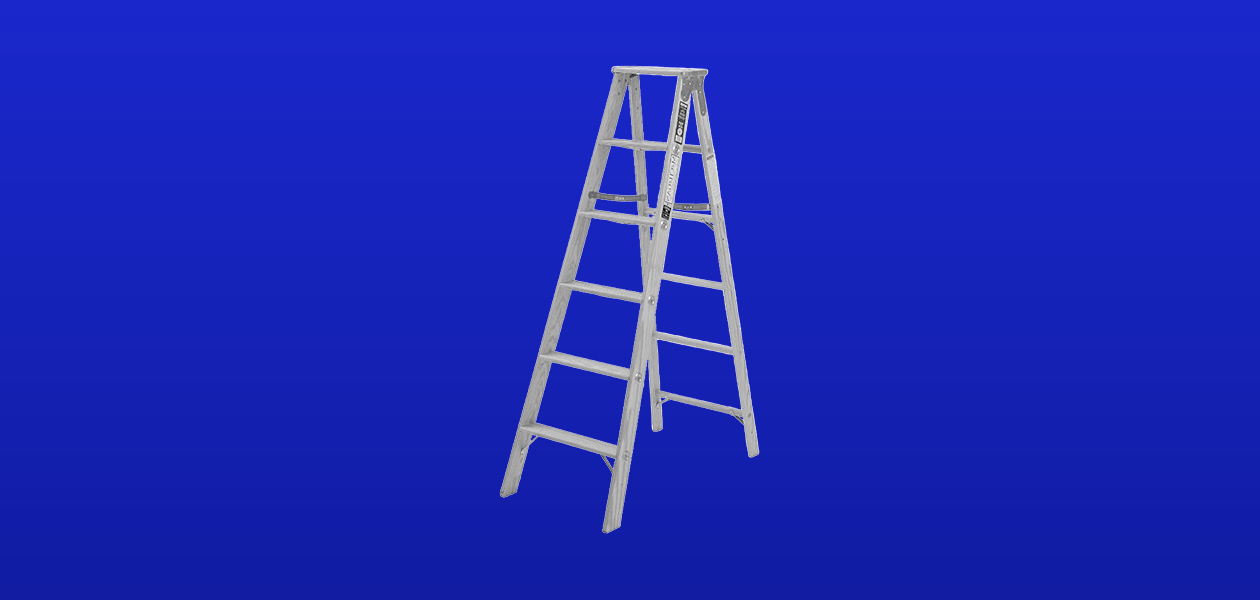Table of contents
The other week, I had a conversation with one of our clients: David Morgan, who runs an independent retail business in Australia.
Earlier this spring and summer we helped rename his business from J&M Floorcoverings to Creme as part of a larger goal to reposition the business into a more premium segment of the market. In this particular conversation, we talked about how the physical space of his shop impacts customers’ perceptions of the quality and value of his products.
When David took over the business, the shop interior looked a lot like many other retail spaces in his industry (flooring and carpets):
Product displays covered the walls from top to bottom. In front of these, even more (albeit lower) product displays. In the centre of the shop floor, there were rolls of carpet stacked on top of each other. The previous owner had designed the layout of the store to contain as much product as possible, but David and I were in agreement: it felt cramped and kind of messy.
I mentioned something to David that piqued his interest: my bet is that once the shop is tidied up and the range on display dramatically decreased, his sales will increase.
That might not come as a surprise to you. The importance and value of simplicity is one of our foundational beliefs at CultMethod, after all. In everything we do, we strive to find the essence and cut out the noise. Unnecessary complexity seldom makes anything better.
Now, that might sound like heresy to some retailers. The way to generate more sales revenue is to offer a wider range of products. That way, consumers are more likely to find something that they like. Right?
You might be surprised to find out that behavioral psychology actually disputes this idea.
What the scientific literature has to say
There are two terms that you’ll want to acquaint yourself with. They both describe roughly the same idea:
The paradox of choice, and Overchoice (or choice overload).
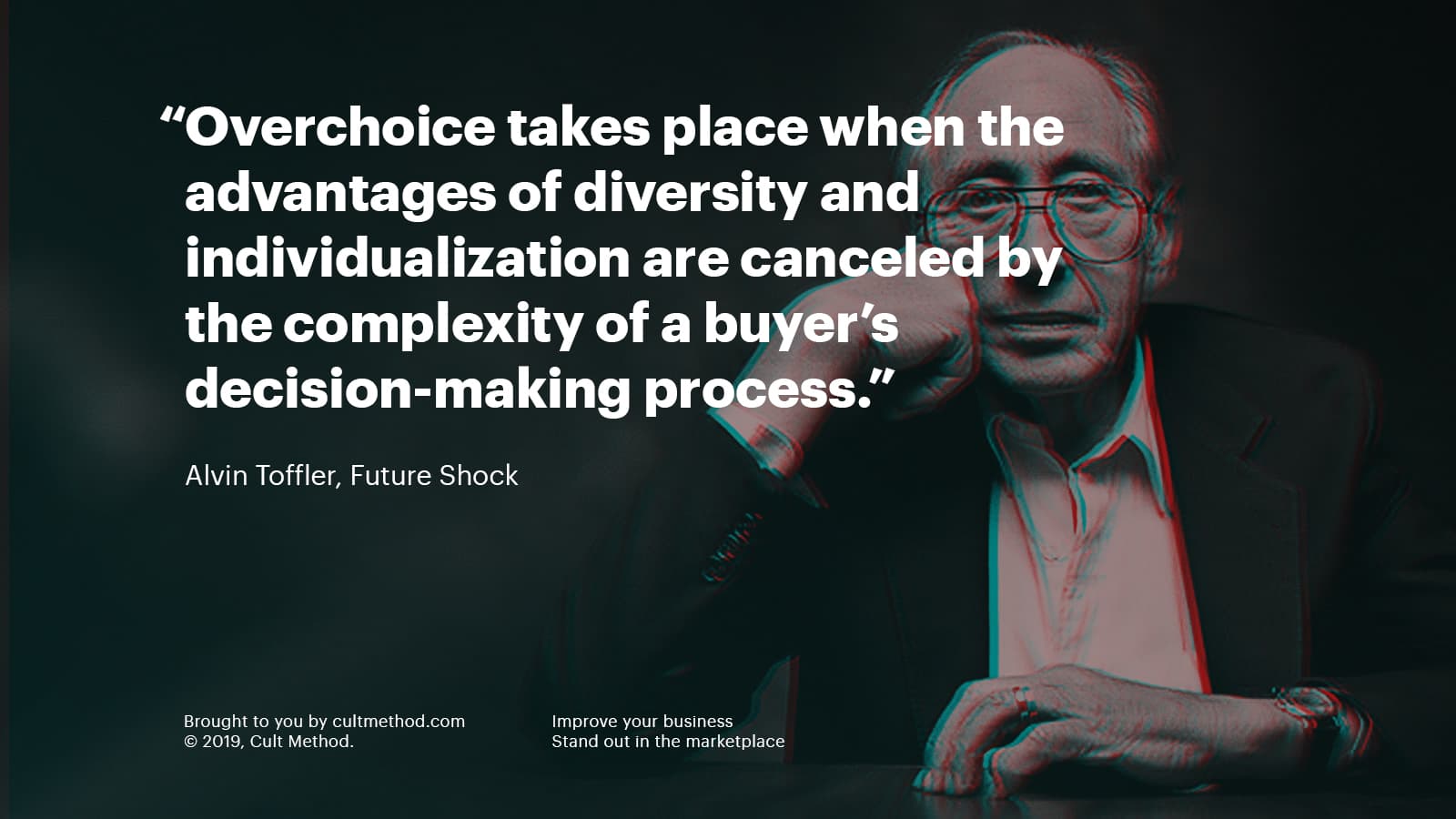
Overchoice takes place when the advantages of diversity and individualization are canceled by the complexity of a buyer’s decision-making process.”
—Alvin Toffler (Future Shock, 1971)
The idea is that when we are faced with a wide range of choices, it becomes more difficult for us to make a decision, and we fall victim to something called analysis paralysis.
The idea has been around since ancient times. In one of Aesop’s fables, The Fox and the Cat, the fox brags that he has “hundreds of ways of escaping” while the cat has “only one”. But when they hear the hounds coming for them, the cat climbs up a tree while “the fox in his confusion was caught up by the hounds.”
The moral? Better one safe way than a hundred on which you cannot reckon.
Recently, psychologists have investigated the phenomenon as it relates to consumer behaviour.
In a famous study published in the year 2000, researchers at Columbia University and Stanford University found that actually, increasing your product range may be counterproductive to increasing sales revenue.
You can read the study yourself here if you’d like. I’ll also include all sources at the bottom of this post in case you want to review them later. In any case, here are the cliff notes:
People are more likely to purchase gourmet jams or chocolates or to undertake optional class essay assignments when offered a limited array of 6 choices rather than a more extensive array of 24 or 30 choices. Moreover, participants actually reported greater subsequent satisfaction with their selections and wrote better essays when their original set of options had been limited.
And in 2015, a large meta-analysis that looked at the findings of 99 other studies, researchers at Northwestern University concluded the same thing. When you account for other variables that might reduce or increase decision fatigue, the overall effect of your product range—in and of itself—on overchoice is significant.
So…
More products = more decision fatigue = fewer sales.
But even more than that, even when people do make a decision in spite of experiencing choice overload, they are actually more likely to second-guess their decision and are more likely to feel unsatisfied with the product they bought. With so many choices on the table, how can you be sure you actually picked the best one?
In retail, less is more. My whacky opinion Now, I would take this idea of “less is more” one step further. I haven’t discovered any psychology research that backs this up, but I strongly suspect it to be true:
By increasing the quantity of products that you sell, you decrease the perceived quality and value of each individual product.
There is a reason why we associate the word “boutique” with luxury, and it’s not just because the word is French. No, small scale implies high touch and high quality.
Compare the quantity that H&M offers consumers to the quantity that a retailer like Brooks Brothers or Burberry offers. Compare Walmart to Whole Foods.
All major low-priced brands focus on range. Their retail spaces consist of tens of thousands of square footage filled with clothing racks and product displays. For women, they don’t have just 5 or 10 different blouses. They have 50. For men, they don’t have just 5 or 10 different t-shirts. They have 50 (or at least 20).
These retailers are banking on becoming a one-stop shop for low-priced products in their category. They are betting that people who come into their retail space will leave not just with one or two products, but half a dozen.
And they can afford to make those bets. When you are a multi-billion-dollar brand, you can achieve the economies of scale required to profitably sell products at a fraction of the price of smaller competitors.
The problem is, this business model isn’t for everyone. As Simon Sinek points out in Start With Why, selling based on price is expensive:
Price always costs something. The question is, how much are you willing to pay for the money you make?
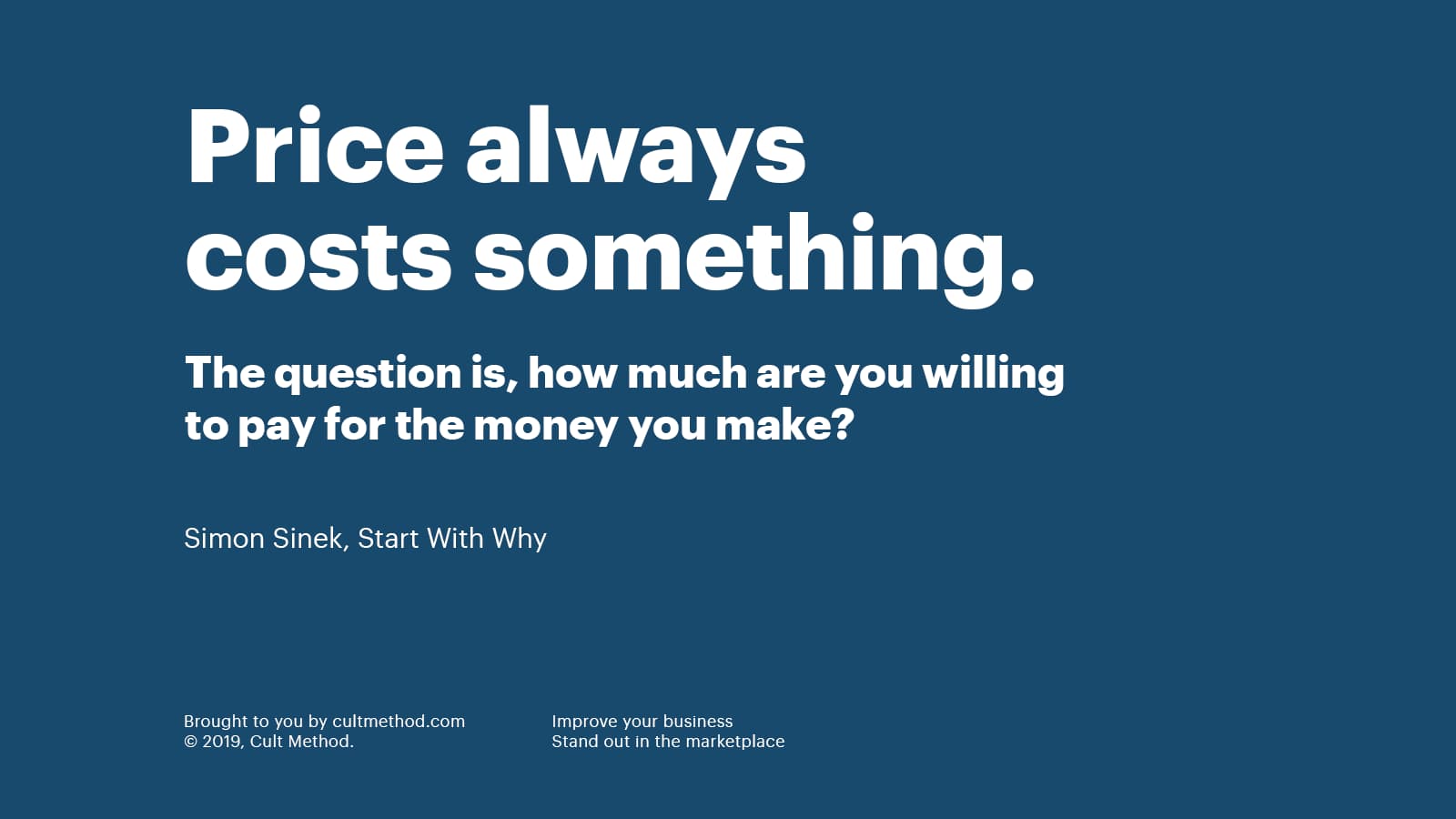
There are a lot of successful retailers who have chosen to go a different route. You can find them both among the independent, locally-owned operations as well as the billion-dollar brands of the world.
Rather than appealing to people’s wallets, these companies appeal to people’s hearts.
They have climbed the ladder of Maslow’s needs, from the basics to self-esteem and aesthetic needs. What they offer are not clothes, or furniture, or books: They help customers construct their own personal identities. Because of this, the value of their goods and services is much greater.
And I don’t think it’s a coincidence that the retail spaces of these companies look much different from their mass-market, low-price counterparts.
The H&Ms of the world do what they can to maximize exposure to the aggregate of their product range. High-end stores focus on creating an atmosphere—and maximizing exposure to individual products in their range.
If you go to H&M looking for a sweater, you have at least a dozen to choose from, and probably even more than that. If you go to a Ralph Lauren store, you might have four or five (if even that). In the H&M, you’ll find them hanging on a clothing rack next to dress shirts. You have to pull them out to see what they look like. In the Ralph Lauren store, they lay neatly folded on a solid wood table or in a solid wood bookcase.
Which sweater would you assume is more valuable: the one squeezed into a clothing rack hit by harsh lighting, and red signs that scream “SALE” in the background? Or the one neatly folded and put on display on a backdrop of rich mahogany, next to a slightly aged chesterfield sofa?

When you buy an expensive brand, you buy into a set of values. You choose to attach your identity to a certain type of lifestyle. It’s a way to construct your identity, but also to signal that identity to the rest of the world. Choosing to wear Ralph Lauren polos as opposed to Uniqlo polos says something about who you are. The way Ralph Lauren stores are designed help reinforce the brand’s image as tasteful, premium, and timeless.
Here’s something I just thought of:
The more expensive the consumer brand, the closer the buying experience comes to that of a modern art gallery.
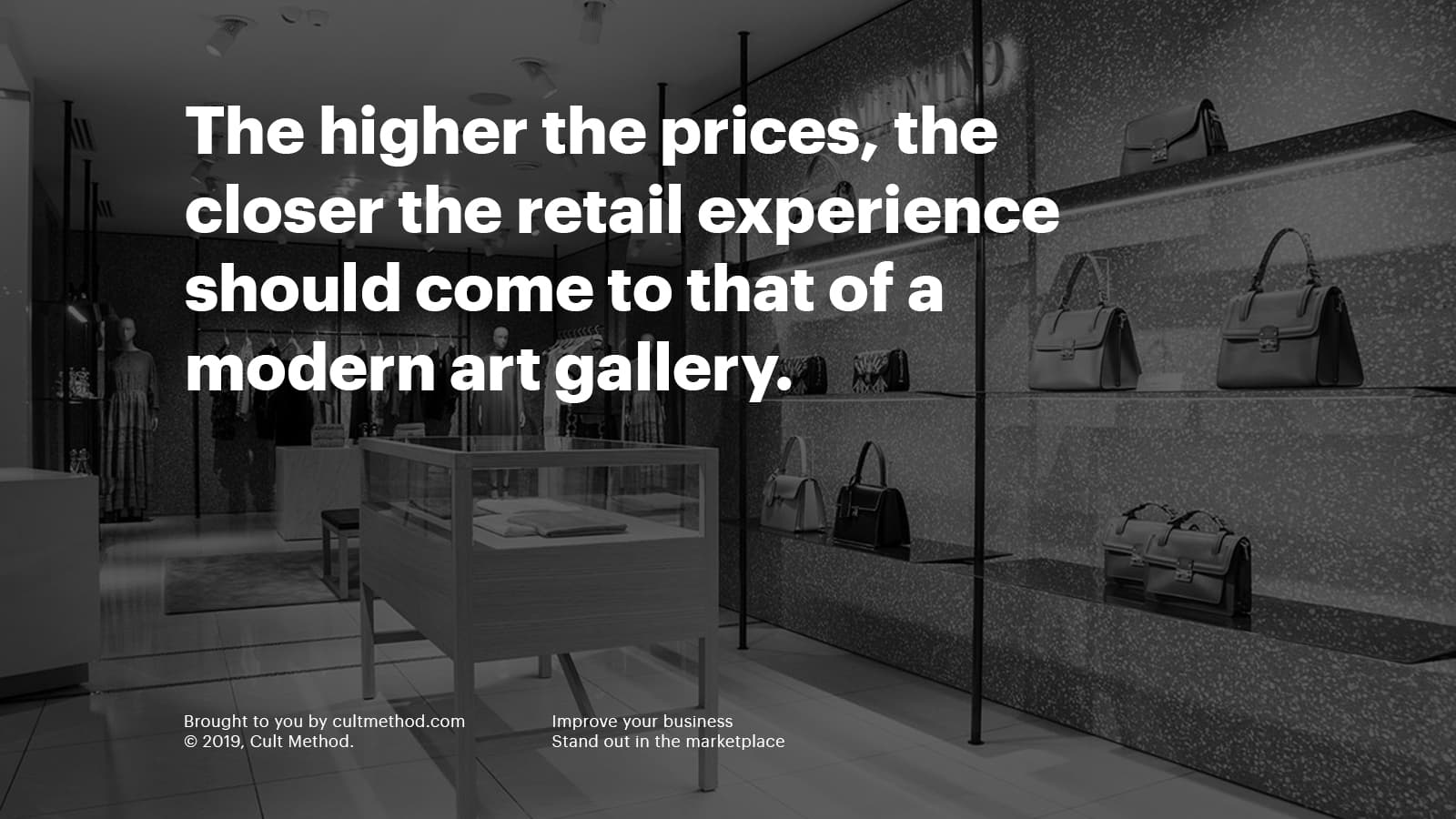
The way you display your products influences the way they are perceived. Treat them as though they were expensive works of art, and people will perceive their value to be closer to that of expensive works of art. My whacky opinion, vindicated My dear client Ed Latimore brought up a really interesting example the other day. I was sharing my theory with him and he reminded me of the PR stunt that the American discount retailer Payless pulled.
In 2018, Payless opened a fake luxury store — “Palessi” — to see how much money people were willing to spend on their low-priced shoes. Turns out, people were willing to spend as much as $640 for $39 boots.
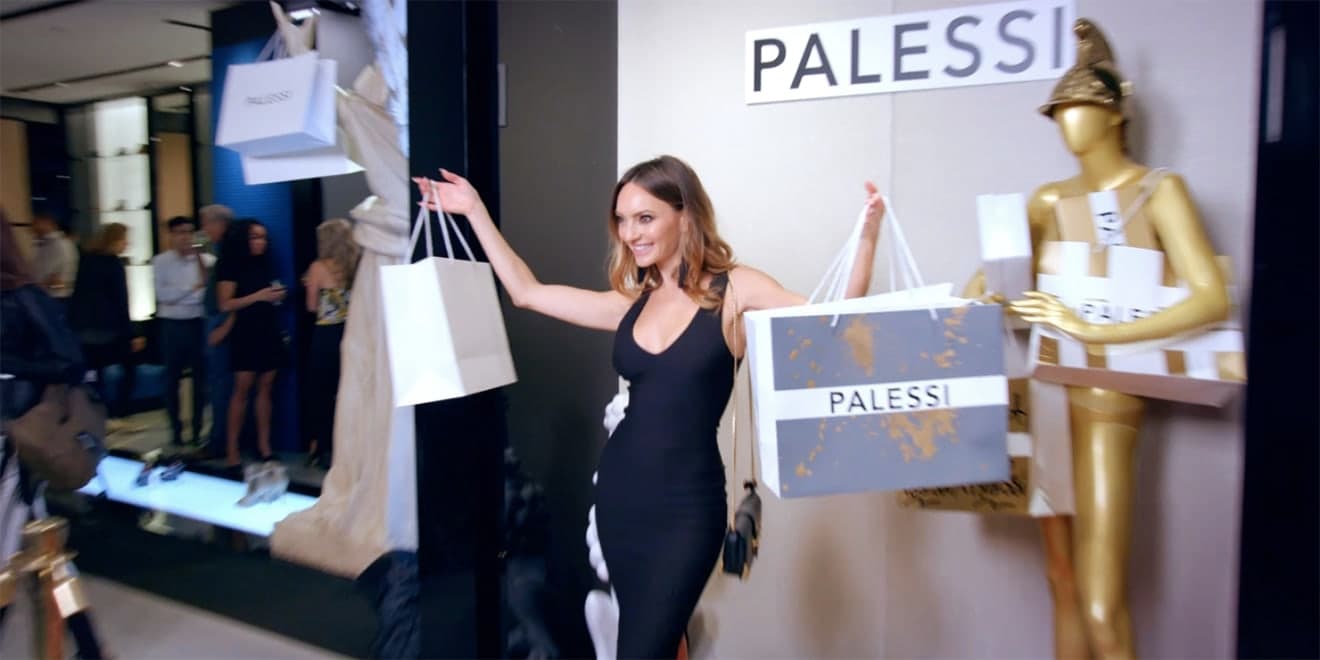
Not only was this a genius marketing move: the campaign received millions of impressions on a tiny media budget. It’s also a strong piece of evidence in support of my theory: perceived value is all about presentation. Especially for first-time buyers who haven’t experienced the quality of your products yet.
How to simplify the buying experience to avoid decision fatigue
Okay, so you own a retail business (or in fact, any type of business—these principles apply just as much to a consulting firm as they do to a consumer-facing retailer). You want to apply these insights to improve the buying experience for your customers. How can you do that?
The first step is to review your product range and identify which products are your best-sellers, and which ones are not performing well. As per the pareto principle, you might find that about 20% of your products generate 80% of your revenue. Look at your lowest-performing SKUs and get rid of them.
You will probably also realize that you carry a lot of items which are fairly similar to each other. These are inevitably going to complicate the decision-making process for your customers: it’s much easier to choose between two very different things (you either want cake, or you want steak) than it is to choose between two very similar things (do you want this strawberry cake or this barely-different strawberry cake? Which one is better? Who knows!). Try to minimize the amount of redundancy in your product range.
How to reduce complexity without eliminating any options
Of course, it may not always make sense to eliminate options. Sometimes, the brands that you stock may not even allow you to do so.
And if you are trying to position yourself as a premium store, there may be another way. I call it “the decision funnel”.
Let me illustrate the idea with a story. I was recently in the market for a new bed. I went to my local furniture store (part of a national franchise) to see what they had on offer.

Immediately, I felt overwhelmed. There were at least twenty different models to choose from, and beyond looking at the price tags I had no idea how to evaluate them or what to look for. Fortunately, a young salesperson approached me. “Yes!” I thought, “I’m sure she can help me figure this thing out.”
Her first question: Was I looking for a single bed or double bed? “Double.” Then she asked me what width I wanted: 140cm, 160cm, 180cm, or 200cm? “Uhh, I’m not sure, I think 140cm or 160cm—I hate it when a bed looks too large for the room it’s in.”
So far, pretty good.
Then she asked me if I was looking for a continental bed, an adjustable bed, or a frame bed. “No idea. I don’t need an adjustable bed, but what are the differences between a continental bed and a frame bed?” She proceeded to explain. I still didn’t fully understand the difference, but my takeaway was that continental beds tend to be more comfortable.
She proceeded to show me a number of continental beds. But that’s where it all broke down. Turns out, there are different types of mattresses. Suddenly, I was confronted with a plethora of choices:
- Innersprings vs. pocket springs vs. pocket springs with a little slit in them
- Mattress firmness: soft, medium, or firm
- The number of pocket “zones”: one, three, five, or seven
- And still, the choice between 140cm and 160cm width
- Different colors and aesthetic differences
It felt overwhelming, and I didn’t know where to begin to narrow down my options. Trying out the beds did not make things any easier. They all felt very similar, and the sensations blended together. I thanked her for her help and walked home with a product brochure. Who knew buying a bed could be so difficult!
Fast forward a couple of weeks, I had just moved into a new apartment in a new city. I went to the local furniture store. Still the same franchise, by the way.
They had all of the same beds as the last place. I was fully prepared to try a bunch of them and leave the store none the wiser. But this time, I was approached by an older, presumably more experienced salesperson. To my surprise, the decision-making process was a lot easier this time around. I felt a lot less anxiety.
Sure, some of it may have had to do with the fact that I’d had some time to think since last time. But I attribute most of it to the expertful way in which she approached the sales process. Not only was she very consultative, but she made everything simple.
First, we decided on the appropriate width. I told her I was thinking of going with 140cm or 160cm. She recommended that I choose 160cm, because unlike the 140cm option, it would be separated into two different “halves” (i.e., movement on the left side would not affect the right side a lot), and it would not look noticeably wider. I agreed.
Next, we talked about the firmness of the mattress. After comparing them a couple of times, I found the “firm” option more comfortable. So logically, we decided to go with the firm option.
Once that matter had been settled, we moved on. Did I want three, five, or seven zones? I compared three different firm mattresses, each with a different amount of zones. (If you were wondering, a mattress can be divided into “zones”: the top zone, which adjusts to the weight of your head, the middle, which adjusts to the weight of your butt, and so on.) When the number of zones was all I had to focus on, I noticed a slight difference between the options. Eventually, I decided to go with 5 zones: I felt it was the right compromise between price and comfort.
Once all of that had been decided, we looked at different colors. Did I want grey, black, or beige? After some deliberation, I decided beige was the way to go. It was neutral, but warmer than grey.
I left the store having placed an order for a bed, and that was that.
By confronting me with just one decision at a time, she had reduced the stress and doubt that I felt. She had designed the buying experience into a funnel, guiding me through the landscape until all of a sudden, I had arrived at a final decision. Magic!
Here is an illustration of the sequential decision funnel. You guide customers through one small decision at a time, until they have narrowed down their options to just one:
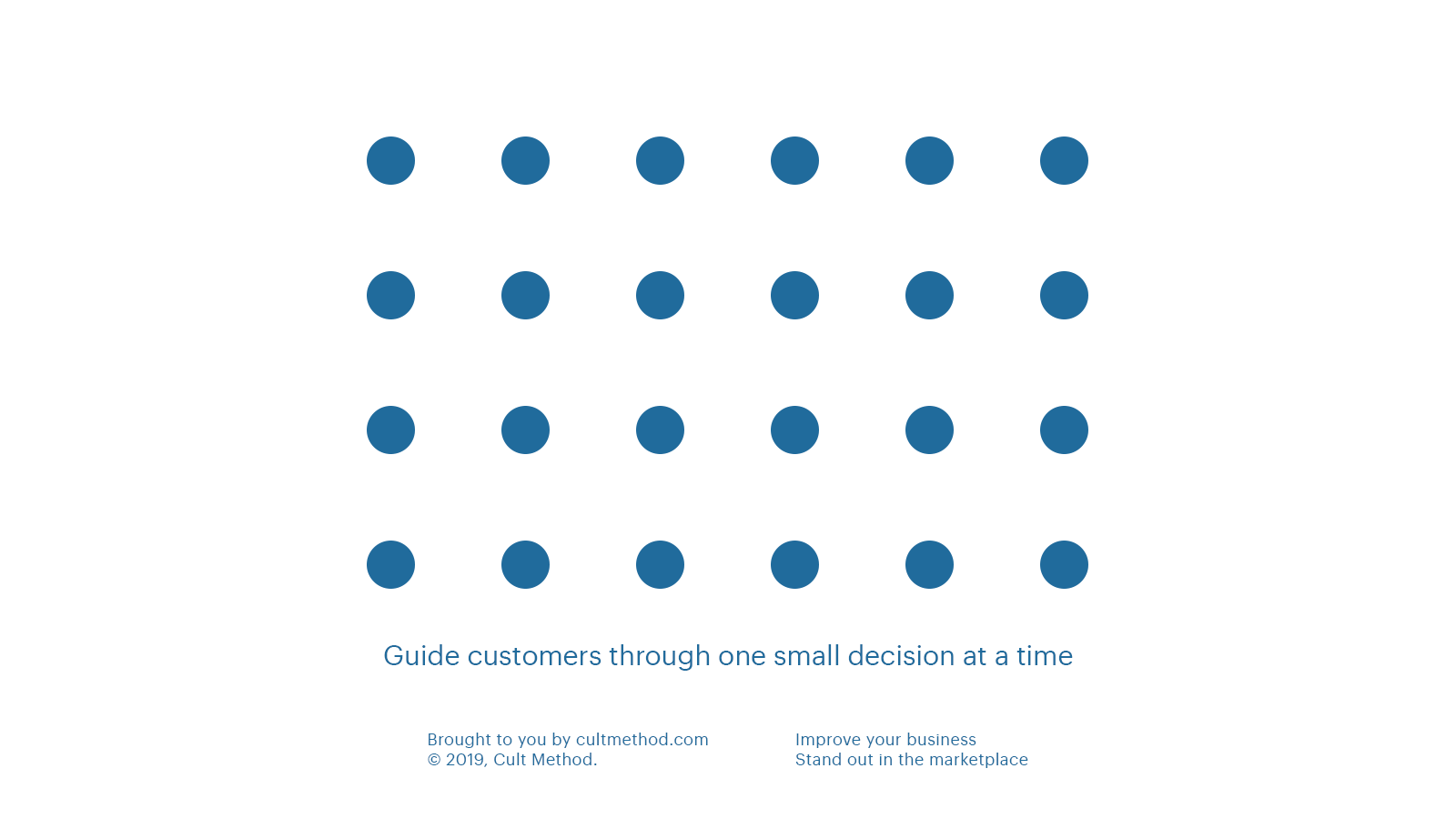
Does the future of retail lie in solving the paradox of choice? While reading about the retail industry one day, I came across a blog post by Nic Brisbourne, a managing partner at a London-based venture capital firm. He has several retail businesses in his portfolio, and believes that retail businesses need to change if they want to stay competitive in this new landscape of e-commerce.
The widespread adoption of e-commerce has enabled consumer brands and manufacturers to form direct relationships with consumers. They are able to cut out the middle-man and capture the retail margin for themselves. As a result, retailers are growing obsolete.
But maybe not.
Yes, retailers are unable to compete with manufacturers on price. That much is obvious. But retailers can add value in three ways:
-
People like to see something in real life before they buy it.
Retail stores are able to activate all the senses of the body. Customers are able to feel the texture of a walnut bookcase before they buy it. They can get a better appreciation of its size and visual weight. Some of these advantages will probably disappear as Augmented Reality becomes increasingly common (already, there are manufacturers in the home improvement industry that enable consumers to envision how different products would look in their home through augmented reality apps on their phones) -
Immediate gratification.
When you order something online, it takes at least a day or two for it to be delivered to you. When you buy something in a physical store, you can wear it the same day -
The personal touch and guidance that real-life salespeople can offer.
If I had done my bed shopping online, I probably still would not have made a decision. This aspect of customer service is, in my mind, the most important benefit that retailers offer—and it’s not going away anytime soon
The opportunity birthed by e-commerce, according to Brisbourne:
Consumers are faced with a new problem – too much choice. The web makes all the products in the world available, and a wealth of research has shown that whilst we say we want choice, too much of it makes us less happy and results in fewer purchases. This is the Paradox of Choice.
Brisbourne believes the future of retail is personal touch:
At its heart new retail will be about personalisation and recommendation, making smart use of data and artificial intelligence to guide people to purchase decisions. Conversational interfaces will be an important secondary part of the mix as each of us will effectively have to programme the services we use and very few of us have the patience to learn syntax and commands for new apps.
A lot of change will be necessary to adjust to this new landscape, and some of it will be painful. But in the end, it will probably be for the better. Brisbourne is mostly talking about e-commerce retailers, but I think the same ideas apply to brick-and-mortar stores as well:
These new retailers will sit between brands/manufacturers and consumers. They will handle less stock, have fewer staff and take less margin than traditional retail, but they could/should be much more profitable. Thread, Stylect and Top10 are good examples of these ‘new retailers’ that we’ve invested in.
The future of retail is in curation, personalization, and high-touch service.
Shareable quotes
“More products = more decision fatigue = fewer sales.” (Tap to tweet)
“In business, less is more” (Tap to tweet)
“When you buy an expensive brand, you buy into a set of values. You choose to attach your identity to a certain type of lifestyle. It’s a way to construct your identity, but also to signal that identity to the rest of the world.” (Tap to tweet)
“The higher the prices, the closer the retail experience should come to that of a modern art gallery.” (Tap to tweet)
“Why the future of retail is in curation, personalization, and high-touch service.” (Tap to tweet)
Further reading
- Full case study of how we repositioned a retail brand. (Read here)
- Toffler, A (1971). Future Shock. (GoodReads link)
- Iyengar, S, and Lepper, M. (2000). When Choice is Demotivating: Can One Desire Too Much of a Good Thing? Journal of Personality and Social Psychology, 79, 995-1006. (Read the PDF)
- Chernev, A, Bockenholt, U, and Goodman, J. (2015). Choice Overload: A Conceptual Review and Meta-Analysis. Journal of Consumer Psychology, 25(2), 333-358. (Abstract + full PDF)
- Stanley, T. (2018, November 28). Payless Opened a Fake Luxury Store, ‘Palessi,’ to See How Much People Would Pay for $20 Shoes. AdWeek. (Read article)
- Brisbourne, N. Retail’s future is to solve the paradox of choice. The Equity Kicker. (Read article)

Jon Persson
Jon Persson
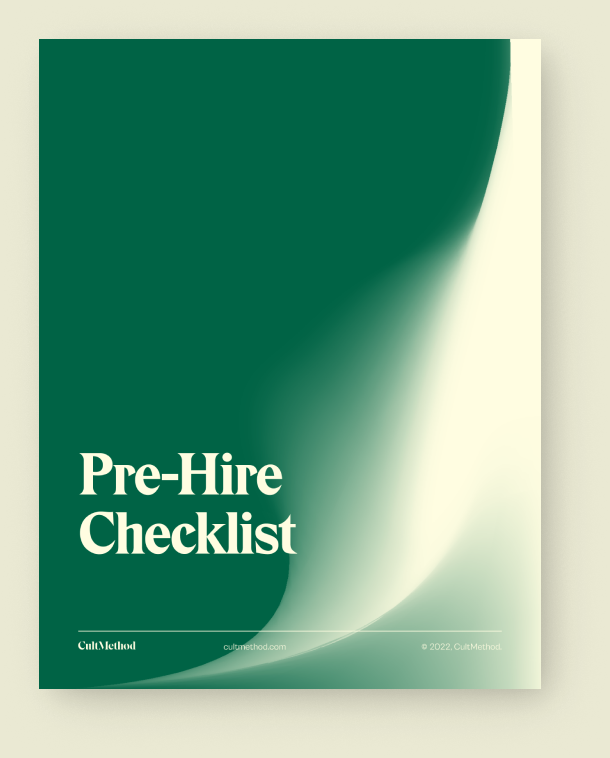
Hiring a designer? Grab this.
My Pre-Hire Checklist gives you valuable tips to consider before hiring an identity designer.


